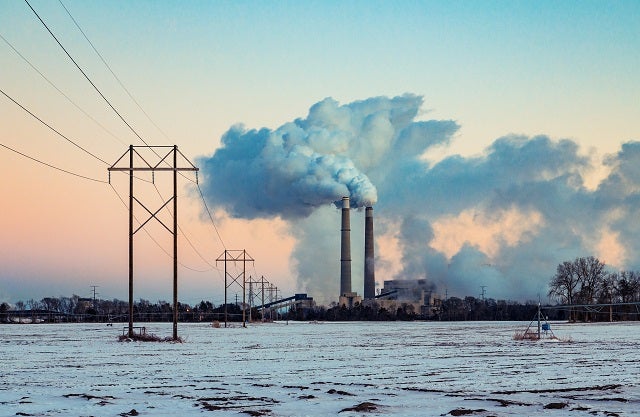
Heat and electricity are responsible for 30% of global greenhouse gas emissions. Photo by Tony Webster/Flickr
Global annual greenhouse gas emissions have grown 41% since 1990, and they are still climbing. While emissions dipped notably in 2016, recent data suggests that carbon dioxide emissions rose each year since then.
Where are these emissions coming from, and who is responsible? WRI’s ClimateWatch platform offers comprehensive emissions data for all countries, sectors and gases. Here’s what we know about the sectors and countries driving greenhouse gas emissions globally:
The Energy Sector Produces the Most Greenhouse Gas Emissions
Energy consumption is by far the biggest source of human-caused greenhouse gas emissions, responsible for a whopping 73% worldwide. The energy sector includes transportation, electricity and heat, buildings, manufacturing and construction, fugitive emissions, and other fuel combustion.
The other top sectors that produce emissions are agriculture, such as livestock and crop cultivation (12%); land use, land-use change and forestry, such as deforestation (6.5%); industrial processes of chemicals, cement and more (5.6%); and waste, including landfills and waste water (3.2%).
Within the energy sector, generation of heat and electricity is responsible for most emissions (15 GtCO2e in 2016, or 30% of total greenhouse gas emissions), followed by transportation (7.9 GtCO2e in 2016, or 15% of total emissions) and manufacturing and construction (6.1 GtCO2e, or 12% of total emissions).
Buildings and Cars are the Main Activities Driving Energy-related Emissions
The middle column of the chart above shows emissions by end-use activities, helping us understand the specific activities from which emissions stem. Activities driving most energy emissions include road transportation (11.9% of total emissions), residential buildings (10.9% of total emissions) and commercial buildings (6.6% of total emissions). Emissions from those activities include both direct emissions from combustion of fossil fuels, as well as indirect emissions such as use of electricity.
The “Other industry” covers a wide range of activities, including non-metallic metals, construction, mining and quarrying, textile and leather, wood and wood products, transportation equipment, and more. These activities collectively consume a large portion of fossil fuels and electricity, and thus produce a large share of emissions.
Industry and Transportation are the Fastest-growing Sources of Greenhouse Gas Emissions
Since 1990, three sectors stand out as the fastest-growing sources of greenhouse gas emissions: Industrial processes grew by 174%, transportation (a subsector of energy) by 71%, and manufacturing and construction (also a subsector of energy) by 55%. The growth in industrial emissions stems primarily from increased use of refrigeration and air conditioning, which produce hydrofluorocarbons (HFCs), potent greenhouse gases. Increased travel by automobiles is the predominant reason transportation emissions are on the rise.
In comparison, emissions from the largest-emitting subsector within the energy sector, electricity and heat generation, increased 78% from 1990-2013, but then dropped by 2% between 2013-2016. The decrease was driven by various factors, including a shift to natural gas from coal and increased use of renewables. However, the latest carbon emissions data suggests that CO2 emissions from energy rose again in 2017 and 2018.
10 Countries Produce More than 68% of Global Greenhouse Gas Emissions
A small number of countries contribute the vast majority of greenhouse gas emissions, with the top 10 emitters accounting for over two-thirds of annual global greenhouse gas emissions. Most of them also have large populations and economies, together accounting for over 50% of the global population and almost 60% of the world’s GDP. China is the biggest emitter at 26% of global greenhouse gas emissions, followed by the United States at 13%, the European Union at 7.8% and India at 6.7%.
Most of the top 10 emitters have higher emissions per person than the world average (around 6.8 tCO2e per person). Among the top 10 total greenhouse gas emitters, Canada and the United States have the highest per capita greenhouse gas emissions at 22 tCO2e per person and 18 tCO2e per person, respectively, while India has the lowest at 2.4 tCO2e per person. China’s per capita emissions (8.5 tCO2e) now surpass those of the European Union (7.1 tCO2e).
Countries such as Qatar and Australia, while not among the top 10 emitters, have higher per capita emissions than most top emitters at 34.8 tCO2e per person and 21.5 tCOe2 per person, respectively.
Carbon Dioxide Makes Up Most, but Not All, Greenhouse Gas Emissions
Carbon dioxide (CO2) comprises 74% of greenhouse gas emissions. Most CO2 emissions (89%) are from the use of fossil fuels, especially for generation of electricity and heat, transportation, and manufacturing and consumption. Land use, land-use change and forestry is another major contributor (7%) to human-made CO2 emissions, mostly due to deforestation.
Methane (CH4) and nitrous oxide (N2O) make up 17% and 6.2% of total greenhouse gas emissions, respectively, mostly from agriculture, waste treatment and gas flaring. Fluorinated gases (comprised of HFCs, PFCs, SF6 and NF3) from industrial processes make up 2% of global emissions. These gases are much more potent than CO2 in terms their global warming potential, and often provide overlooked opportunities for mitigation.
Greenhouse Gas Emissions Must Be Reduced Rapidly to Avert the Climate Crisis
The world is already facing the consequences from climate change. If we are to avoid much more dangerous and costly impacts, current levels of greenhouse gas emissions must be slashed in half by 2030 and reach net-zero by mid-century. The largest emissions sources, like the energy sector, are good places to start. But to fully tackle the climate crisis, we will need deep reductions across all sectors, big and small. Switching to renewable energy, electrifying the transportation sector, introducing more sustainable agriculture practices, curbing deforestation and forest degradation, and producing less waste are a few key ways to drive greenhouse gas emissions downward and set the world on course for a safer future.
This blog originally appeared on WRI’s Insights.
is an Associate for the Climate Program at World Resources Institute.
is a Senior Associate for the Climate Program at World Resources Institute.








